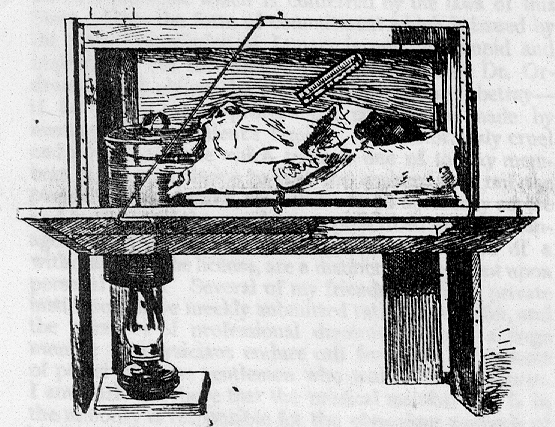A New Baby Incubator
New Instruments.
A New Baby Incubator.
By Edward J. Brown, M.D.
Minneapolis, Minn.
Medical Record 41:446-447, April 16, 1892.
I have lately had an experience in rearing an immature infant which may be of interest to the profession. The child, a healthy and well-formed male, was born September 3, 1891, at the close of the seventh month of gestation. No discoverable cause for the premature birth existed. Labor was of twenty-two hours’ duration, and owing to a brow presentation instrument delivery was necessitated, which was skilfully performed, and without accident, by my family physician, Dr. John A. Crosby.
The child weight 4 1/2 pounds net and was 18 1/2 inches in length, presenting abundant evidence of immaturity.
In view of the immaturity and the symptoms resulting from pressure, the prognosis seemed extremely grave. Consequently I devised and constructed an incubator as a means of affording the most favorable possible conditions in the way of uniform warmth, abundance of fresh air, and freedom from draughts. I had seen in the Medical Record, some months previously, the statement that an incubator had been invented and patented in Paris, and that two of the machines had been brought to New York. As I could find no descriptive data to aid me, I devised, during an idle office hour, and constructed in the evening, mainly from such materials as the family lumber-room afforded, an incubator which has served a most excellent purpose.
On September 8th, when five days old, the child was placed in his box for two weeks, wrapped in cotton and afterward dressed, lying upon a soft hair mattress covered with cotton. He was taken from the box every two hours the first month, and every three hours the second month, fed and changed, and with a daily bath required absolutely no further attention. For two weeks he was fed with breast milk from a spoon and afterwards was able to nurse. In six weeks he had doubled his weight, weighing 9 pounds. When he left the incubator at the end of eight weeks he weight 10 3/4 pounds and measured twenty-two inches, and now, at the end of five months, weighs 17 1/2 pounds and measures twenty-six inches.
The temperature of the interior of the box was maintained at from 86° to 90° during the first month, and gradually lowered to 80° F. during the second. A slight coryza lasting a few days was the only noteworthy event of the whole two months.
The complete incubator consists of a packing box 33 inches long, 21 inches high, and 12 inches wide, inside measure; a false bottom upon which the mattress is placed, and under which the fresh air is admitted, through an opening 4 x 10 inches; a false top with opening over the child’s head for escape of warm air; a three-gallon pail of water, and hot air and smoke flues. The bottom of the box has a hole cut in it to admit the pail, which rests upon a piece of sheet iron under which a lamp or gas-jet is placed. The sheet iron, one foot square, is nailed to the box. The heat from the lamp is concentrated under the pail by a six-inch section of stove-pipe, and the fumes conducted by a two-inch smoke-flue up through the four-inch warm air-escape, thus producing a constant and sufficient current of air through the incubator. The front of the box opens on hinges at the bottom and has a large glass window which affords a view of the child and the thermometer which hangs on the back wall. Filling the pail with water at about 120° F., an ordinary bracket lamp, with very slight attention, will maintain a uniform temperature 15° to 25° F. higher than that of the room. By covering the box with building paper and throwing a folded quilt over it, the temperature may be maintained with less heat from the lamp and consequently with a lower temperature of the pail of water. The pail may be fitted with a tight cover or with openings for evaporation if more moisture be desired in the air. The sheet iron need never be heated to such a point as to be objectionable.
It is easy to suggest improvements, but this incubator was made in an emergency, and I present it to the profession, not as an ideal, but as a simple, practical, labor and life saving device, which any clod-hopper ought to be able to construct in a few hours, and from such materials as are always at hand.
In conclusion, I will suggest that such an apparatus as I have described might be of great use also in cases of disease of the respiratory organs in weak infants where favorable conditions of temperature and freedom from draughts could not otherwise easily be secured.

Minneapolis, February 3, 1892.
Transcribed for the web 11/23/1998
Converted to WordPress 10/20/2024
Last Updated on 10/20/24